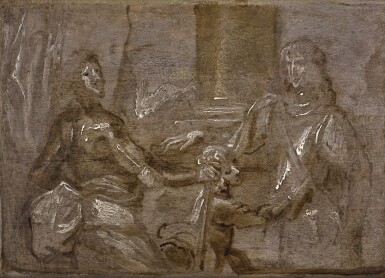Old Masters Day Sale
Old Masters Day Sale

SIR ANTHONY VAN DYCK | Sketch for the double portrait of Mountjoy Blount, 1st Earl of Newport (circa 1597–1666) and George, Lord Goring (1608–57)
Auction Closed
December 5, 12:50 PM GMT
Estimate
20,000 - 30,000 GBP
Lot Details
Description
SIR ANTHONY VAN DYCK
Antwerp 1599 - 1641 London
Sketch for the double portrait of Mountjoy Blount, 1st Earl of Newport (circa 1597–1666) and George, Lord Goring (1608–57)
oil on panel, en grisaille
14.7 x 20.8 cm.; 5¾ x 8¼ in.
Private collection, Norfolk.
This painting is a preparatory sketch for Van Dyck's double portrait of Mountjoy Blount, 1st Earl of Newport and George, Lord Goring, painted circa 1639 (National Trust, Petworth House, Sussex).1 Newport and Goring both held high office in the King's army during the Bishops' Wars, Newport being Master General of the Ordnance, and General of Artillery in the North, while Goring was Lieutenant-General of Cavalry. This composition is believed to commemorate this episode in the two men's careers.
The sketch shows both men in military dress, as in the finished painting, with Goring's sash being tied by a page. The motif is Venetian in origin, and demonstrates the influence of works such as the Giorgionesque so-called Portrait of Gaston de Foix at Castle Howard, in which a young page can be seen fastening the sitter's armour. There are, however, a number of important differences between the present work and the finished painting at Petworth. In the latter, the two principal figures are brought closer together, and Van Dyck alters Newport's pose. On the right, there are further differences in the position of Goring's right arm and in the stance of the page, both of whose arms are brought forward to tie the sash, rather than just the one hand seen in the present work. The prominent column, upon which Goring rests, is also absent in the finished picture, replaced by a dark green silk curtain.
These numerous differences, as well as the rapid nature of the work, all suggest this to be a sketch from the early stages of the commission, possibly the artist's first thoughts for the composition, and as such it is a fascinating insight into his working method. The practice of making small preparatory sketches, as a means of roughing out his design for a composition, possibly in order to convey those ideas to a client, is one that Van Dyck would have learned in Rubens' studio. Indeed, the technique used in this sketch is strikingly similar to parts of Van Dyck's preparatory study for Charles I and the Knights of the Garter in Procession (Ashmolean Museum, Oxford). The distinctive dark eyes, the figures delineated in varying shades of brown, heightened with fluent touches of white, and structural elements drawn in broad areas of very thin paint in the texture of watercolour, are all consistent with the technique practised by Rubens prior to the 1620s, when Van Dyck was working in his studio.2
1 Inv. no. NT 486243; see O. Millar et al., Van Dyck, A Complete Catalogue of the Paintings, New Haven and London 2004, p. 562, cat. no. IV.171, reproduced p. 563.
2 Inv. no. WA2002.55; see Millar 2004, p. 476, cat. no. IV.59, reproduced in colour p. 476.
